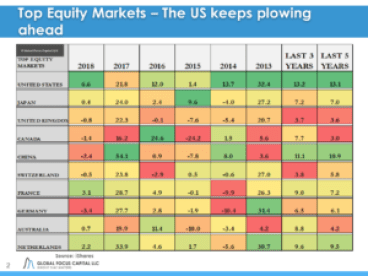 There are so many stories going on in the press about the demise of the active management industry that one gets the impression that every portfolio manager must be feeling like a gambler pawning his last possession.
There are so many stories going on in the press about the demise of the active management industry that one gets the impression that every portfolio manager must be feeling like a gambler pawning his last possession.
I recently attended a wealth management forum put together by Marketwatch were the commonly held view among attendees and panelists was that active management is dead and that the whole investment industry has been commoditized.
Certainly when evaluating security selection strategies relative to passively constructed benchmarks the recent record of active management leaves a lot to be desired. Times have been tough for active management shops and investors have been flocking to a myriad of index strategies. Exchange-traded funds (ETF) and multi-asset class strategies such as Target Date Funds have been the primary beneficiaries.
Barron’s magazine recently reported that only 33 percent of active equity managers managed to beat their benchmark last year. Outflows from actively managed strategies surpassed $288 billion (through November) – worse even than for 2008.
The popular S&P SPIVA report shows that the situation is not any better if one looks at a longer time period. For example, as of June of 2016, only 8 percent of US large cap strategies managed to beat the S&P 500 index over the trailing five years.
Midcap and small cap managers did not fare any differently. How about REIT managers? Not really – only about 11 percent of active strategies beat their index over the last five years.
International equity managers did fare a bit better than their US counterparts with close to 40 percent beating their index over the last five years. 32 percent of emerging market equity managers likewise beat their benchmark. A bit more hopeful but still nothing to write home about!
What about fixed income active strategies? A bit better in smaller pockets of the markets such as municipals, short and intermediate term investment grade where the majority of funds had higher returns than their corresponding index.
But among longer maturity strategies the situation was as abysmal as for equity managers. For example, only 3.5% of Long Government strategies outperformed over the trailing five years. Even in the emerging market debt category only 8 percent of active strategies outperformed.
Is hope the only strategy left for the active investor? Just like the gambler down to his last pennies it sure feels lonely out there. All active management friends seemed to have slithered out the back door.
If the data cannot be tortured to confess, what about using theory to defend active management? Unfortunately, little help seems to be coming from the halls of academia. Many years ago Bill Sharpe published his famous paper on “The Arithmetic of Active Management”. The basic idea that active managers bear higher costs than passive investors thus creating a wedge in performance between the two has stuck as a reasonable theoretical explanation for the under-performance of active management.
Recently, there has been some debate about some of the logic used by Sharpe (see the recent Lasse Pedersen paper) but in general while it is clear that index funds are not totally passive (due to new issues, repurchases, and index membership changes) the consensus still seems to be that the basic disadvantage of active management is due to its higher costs.
Another argument working against active management was espoused by another Nobel Prize winner Paul Samuelson even longer ago. Samuelson held that the stock market is micro-efficient, but macro-inefficient.
What this means is that at the level of individual stocks (where active managers ply their trade) it is much harder to beat the overall market but that the market itself may occasionally exhibit economically significant deviations from fundamental value. Research by Jung and Shiller at Yale corroborates the Samuelson story of micro-efficiency and macro-inefficiency.
Every active manager knows that outperforming benchmarks is tough especially in a consistent manner. A quote by Charlie Ellis of Greenwich Associates has stuck with me over the years. While I can’t remember the exact wording it goes something like this – “outperforming is difficult not because investors are stupid but because they are smart and compete with each other”.
I might have butchered Charlie’s quote but the basic idea is that with so many smart people participating in the markets today active management has become at least conceptually a zero sum game with the additional handicap of higher costs.
What this means is that on a capital weighted basis for every winner there must be a loser (assuming a fairly static market portfolio) but both must bear the burden of higher costs. These costs are especially detrimental in an environment of lower capital market returns such as the one currently anticipated by Global Focus Capital.
Given all the evidence against active management what is the investor to do? Load up on ETF’s and run away from actively managed strategies? The flow of funds data certainly seems to be confirming this behavior. Active equity and bond managers have seen massive outflows to their strategies while flows to ETF’s have grown consistently for over ten years.
Continue reading
Sincerely,
Eric J. Weigel
Managing Partner, Global Focus Capital LLC
| DISCLAIMER: NOTHING HEREIN SHALL BE CONSTRUED AS INVESTMENT ADVICE, A RECOMMENDATION OR SOLICITATION TO BUY OR SELL ANY SECURITY. PAST PERFORMANCE DOES NOT PREDICT OR GUARANTEE FUTURE SIMILAR RESULTS. SEEK THE ADVICE OF AN INVESTMENT MANAGER, LAWYER AND ACCOUNTANT BEFORE YOU INVEST. DON’T RELY ON ANYTHING HEREIN. DO YOUR OWN HOMEWORK. THIS IS FOR INFORMATIONAL PURPOSES ONLY AND DOES NOT CONSIDER THE INVESTMENT NEEDS OR SUITABILITY OF ANY INDIVIDUAL. THERE IS NO PROMISE TO CORRECT ANY ERRORS OR OMISSIONS OR NOTIFY THE READER OF ANY SUCH ERROR
|























